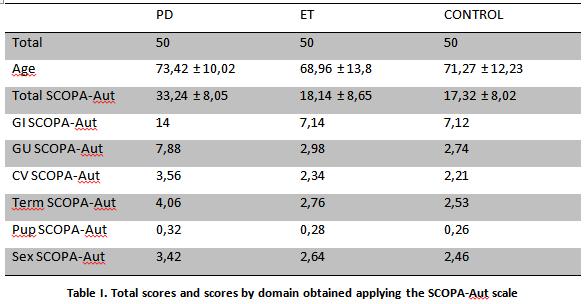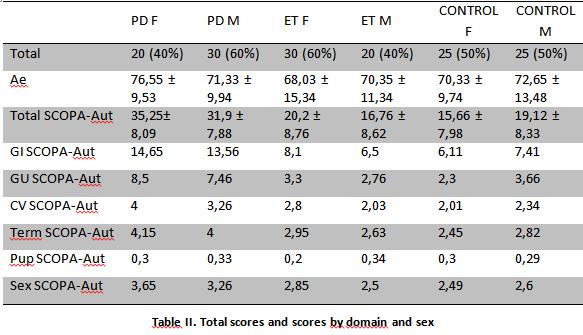Session Information
Date: Wednesday, September 25, 2019
Session Title: Non-Motor Symptoms
Session Time: 1:15pm-2:45pm
Location: Agora 3 West, Level 3
Objective: To compare the presence of autonomic symptoms on Parkinson’s disease (PD) and essential tremor (ET) applying the Scale for Outcomes in Parkinson’s disease for Autonomic Symptoms (SCOPA-Aut)
Background: For years the relationship between Parkinson’s disease and essential tremor has remained controversial. Although both are different diseases, there is great evidence of clinical overlap between both of them. Despite all the similarities between both diseases, and the extensive evidence regarding the autonomic component of Parkinson’s disease, little or nothing has been studied with respect to the possible presence of autonomic symptoms in essential tremor.
Method: Fifty patients with PD, 50 with ET and 50 healthy controls of similar ages and sexes attended in outpatient consultation between the months of May and November 2017 were evaluated applying the SCOPA-Aut questionnaire and the results were compared.
Results: The average age was higher in patients with PD (73.42 ± 10.02). The proportion of women was 40% versus 60% of men in PD, unlike ET where the proportion was inverse. The average scores of SCOPA-Aut are much higher in patients with PD than with ET and controls, the last two achieving similar scores. Women obtained higher scores than men in the SCOPA-Aut, both in the PD and ET groups; the gastrointestinal and urinary domains obtained the highest scores. A correlation was observed between age and the score obtained in the SCOPA-Aut.
Conclusion: It can be concluded from these results that autonomic symptoms in patients with essential tremor are not different from those presented by healthy controls, unlike patients with Parkinson’s disease. This would not be an area of clinical overlap between PE and the TEA. Also it can be said that there is a relationship between age and the number of dysautonomic complications observed.
References: 1. Adler CH. Nonmotor complications in Parkinson’s disease. Mov Disord 2005; 20 (Suppl. 11):S23-9. 2. Chaudhuri KR, Yates L, Martinez-Martin P. The non-motor symptom complex of Parkinson’s disease: time for a comprehensive assessment. Curr Neurol Neurosci Rep 2005; 5: 275–83. 3. Chaudhuri KR. Autonomic dysfunction in movement disorders. Curr Opin Neurol 2001; 14: 505–11. 4. Jost WH. Autonomic dysfunctions in idiopathic Parkinson’s disease. J Neurol 2003;250(Suppl. 1):I28 –I30. 5. Chaudhuri KR, Healy DG, Schapira AH. Non-motor symptoms of Parkinson’s disease: diagnosis and management. Lancet Neurol 2006;5:235-45. 6. Pfeiffer RF. Gastrointestinal dysfunction in Parkinson’s disease. Lancet Neurol 2003; 2: 107–16. 7. Goldstein DS. Dysautonomia in Parkinsons`s disease: neurocardiological abnormalities. Lancet Neurol Nov 2003;2(11):669-76. 8. Sakakibaya R, Uchiyama T, Yamanishi T, Shirai K, Hattori T. Bladder and bowel dysfunction in Parkinson’s disease. J Neural Transm 2008;115(3):443-60. 9. Swinn L, Schrag A, Viswanathan R, Bloem BR, Lees A, Quinn N. Sweating dysfunction in Parkinson’s disease. Mov Disord 2003;18:1459-63. 10.Yu M, Roane DM, Miner CR, Fleming F, Rogers JD. Dimensions of sexual dysfunction in Parkinson Disease. Am J Geriatr Psychiatry 2004; 12: 221–26. 11.Pezzella FR, Colosimo C, Vanacore N, et al. Prevalence and clinical features of hedonistic homeostatic dysregulation in Parkinson’s disease. Mov Disord 2005; 20: 77–81. 12.Louis ED, Ferreira JJ. How common is the most common adult movement disorder? Update on the worldwide prevalence of essential tremor. Mov Disord 2010; 25: 534-41. 13.Deuschl G, Elble R. Essential tremor–neurodegenerative or nondegenerative disease towards a working definition of ET. Mov Disord 2009; 24: 2033-41. 14.Jankovic J. Essential tremor: A heterogeneous disorder. Mov Dis 2002;17:638–644 15.Singer C, Sanchez-Ramos J, Weiner WJ. Gait abnormality in essential tremor. Mov Disord 1994;9:193–196. 16.Lacritz LH, Dewey R Jr, Giller C, Cullum CM. Cognitive functioning in individuals with _benign_ essential tremor. J Int Neuropsychol Soc 2002;8:125–9. 17.Gasparani M, Bonifati V, Fabrizio E et al. Frontal lobe dysfunction in essential tremor: a preliminary study. J Neurol 2001;248:399–402. 18.Louis ED, Barnes LF, Albert SM et al. Correlates of functional disability in essential tremor. Mov Disord 2001;16:914–20. 19.Ozel-Kizil ET, Akbostanci MC, Ozguven HD, Atbasoglu EC. Secondary social anxiety in hyperkinesias. Mov Disord 2008;23:641–5. 20.Chandran V, Pal PK, Reddy JY, Thennarasu K, Yadav R, Shivashankar N. Nonmotor features in essential tremor. Acta Neurol Scand Jul 20, 2011 21.Applegate, L. M., & Louis, E. D. (2005). Essential tremor: Mild olfactory dysfunction in a cerebellar disorder. Parkinsonism & Related Disorders, 11(6), 399–402. 22.Shah, M., Muhammed, N., Findley, L. J., & Hawkes, C. H. (2008). Olfactory tests in the diagnosis of essential tremor. Parkinsonism & Related Disorders, 14(7), 563–568. 23.Benito-Leon, J., Louis, E. D., Bermejo-Pareja, F., & Neurological Disorders in Central Spain Study Group. (2007). Reported hearing impairment in essential tremor: A population based case-control study. Neuroepidemiology, 29(3–4), 213–217. 24.Visser M, Marinus J, Stiggelbout AM, Van Hilten JJ. Assessment of autonomic dysfunction in Parkinson’s disease: the SCOPA-AUT. Mov Disord 2004;19:1306e12. 25.Rodriguez-Blazquez C, Forjaz MJ, Frades-Payo B, de Pedro-Cuesta J, Martinez-Martin P. Independent validation of the scales for outcomes in Parkinson’s disease-autonomic (SCOPA-AUT). Eur J Neurol 2010;17:194e201. 26.Verbaan D, Marinus J, Visser M, van Rooden SM, Stiggelbout AM, van Hilten JJ. Patient-reported autonomic symptoms in Parkinson disease. Neurology 2007;69:333e41. 27.Damian A, Adler CH, Hentz JG, Shill HA, Caviness JN, Sabbagh MN, Evidente VG, Beach TG, Driver-Dunckley E (2012) Autonomic function, as self-reported on the SCOPA-autonomic questionnaire, is normal in essential tremor but not in Parkinson’s disease. Parkinsonism Relat Disord 18:1089–1093 28.Blonsky ER, Logemann JA, Boshes B, Fisher HB. Comparison of speech and swallowing function in patients with tremor disorders and in normal geriatric patients: a cinefluorographic study. J Gerontol 1975;30:299e303. 29.Kim JS, Song IU, Shim YS, Park JW, Yoo JY, Kim YI, et al. Cognitive impairment in essential tremor without dementia. J Clin Neurol 2009;5:81e4.
To cite this abstract in AMA style:
J. Gonzalez. Comparison of autonomic symptoms on Parkinson’s disease and essential tremor with SCOPA-AUT [abstract]. Mov Disord. 2019; 34 (suppl 2). https://www.mdsabstracts.org/abstract/comparison-of-autonomic-symptoms-on-parkinsons-disease-and-essential-tremor-with-scopa-aut/. Accessed December 16, 2025.« Back to 2019 International Congress
MDS Abstracts - https://www.mdsabstracts.org/abstract/comparison-of-autonomic-symptoms-on-parkinsons-disease-and-essential-tremor-with-scopa-aut/


